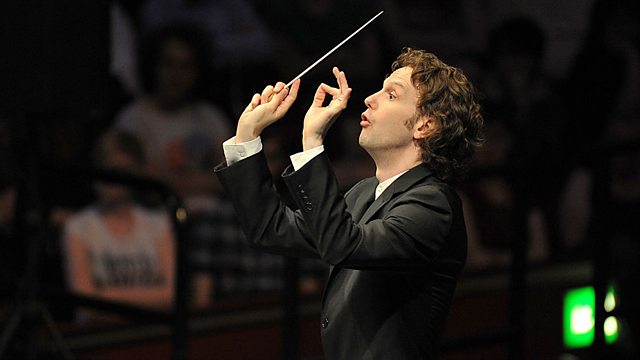
Ravel’s Piano Concerto and La Valse
Ravel’s Piano Concerto and La Valse, plus a Messiaen world premiere. Jean-Efflam Bavouzet, solo piano, 91�ȱ� Philharmonic conducted by Nicholas Collon.
Ravel: Piano Concerto in G
Messiaen (orch. Dingle): Un Oiseau des Arbres de Vie (world premiere)
Ravel: La Valse
Jean-Efflam Bavouzet (piano)
91�ȱ� Philharmonic
Nicholas Collon (conductor)
Two masterworks by France’s best-loved 20th century composer, separated by a world premiere of a short but vivid piece by the late Olivier Messiaen. The pianist Jean-Efflam Bavouzet is one of today’s most engaging performers and has a special affinity with the music of his fellow Frenchmen.
91�ȱ� Radio 3 presenter Andrew McGregor is joined by historian of Modern France Alison Carrol.
Maurice Ravel (1875 – 1937)
Piano Concerto in G (1929/31)
After the cataclysm and privations of the First World War, people of Europe longed to have fun. And there was new music to have fun with, as a listener, dancer or musician: jazz. Maurice Ravel was smitten: “The most captivating part of jazz is its rich and diverting rhythm. Jazz is a very rich and vital source of inspiration for modern composers and I am astonished that so few Americans are influenced by it." The Piano Concerto in G is one of the most popular modern concertos.
Olivier Messiaen (1908 – 1992)
Un Oiseau des Arbres de Vie (World premiere)
Orchestrated by Christopher Dingle
If you had called the late Olivier Messiaen a bird-watcher, he would have probably taken it as a compliment: birdsong was a constant source of inspiration to him and he incorporated a wide variety into his melodies. Messiaen’s last work, Éclairs sur l'au-delà… (Illuminations of the beyond…) was originally to have 12 movements, but the composer then reduced it to 11: the 12th piece is played for the first time at this year’s Proms, orchestrated by Christopher Dingle. It includes Messiaen’s take on the songs of the New Zealand Tui (parson) birds which range from bell-like sounds, to clicks, creaks and even imitations of human speech.
Last on
More About The Music
Ravel: Piano Concerto in G
Messiaen (orch. Dingle): Un Oiseau des Arbres de Vie (world premiere)
Ravel: La Valse
Jean-Efflam Bavouzet (piano)
91�ȱ� Philharmonic
Nicholas Collon (conductor)
Two masterworks by France’s best-loved 20th century composer, separated by a world premiere of a short but vivid piece by the late Olivier Messiaen. The pianist Jean-Efflam Bavouzet is one of today’s most engaging performers and has a special affinity with the music of his fellow Frenchmen.
91�ȱ� Radio 3 presenter Andrew McGregor is joined by historian of Modern France Alison Carrol.
Maurice Ravel (1875 – 1937)
Piano Concerto in G (1929/31)
After the cataclysm and privations of the First World War, people of Europe longed to have fun. And there was new music to have fun with, as a listener, dancer or musician: jazz. By Armistice there were about 2 million US soldiers in France and among them outstanding African American musicians playing early forms of jazz. They were quickly followed by civilians, including George Gershwin, who brought the next wave of exciting sounds to Paris.
Maurice Ravel was smitten: “The most captivating part of jazz is its rich and diverting rhythm. Jazz is a very rich and vital source of inspiration for modern composers and I am astonished that so few Americans are influenced by it." Ravel’s trip to America at the end of the 1920s included further immersion in jazz, including evenings in Harlem clubs. The results are clearly audible in the Piano Concerto, making it one of the most popular modern concertos. But don’t be fooled by the carefree, effortless surface of the work: it hides lots of exquisite artistry underneath. Just listen to the seemingly endless melody opening the slow second movement.
Olivier Messiaen (1908 – 1992)
Un Oiseau des Arbres de Vie (World premiere)
Orchestrated by Christopher Dingle
If you had called the late Olivier Messiaen a bird-watcher, he would have probably taken it as a compliment: birdsong was a constant source of inspiration to him and he incorporated a wide variety into his melodies. Messiaen’s last work, Éclairs sur l'au-delà… (Illuminations of the beyond…) was originally to have 12 movements, but the composer then reduced it to 11: the 12th piece is played for the first time at this year’s Proms, orchestrated by Christopher Dingle. It includes Messiaen’s take on the songs of the New Zealand Tui (parson) birds which range from bell-like sounds, to clicks, creaks and even imitations of human speech.
Maurice Ravel (1875 – 1937)
La Valse (1919/20)
Ravel was a shy man, to the point of being reclusive. He was also a consummate musical craftsman, polishing every detail of his works. Add a French penchant for clarity and elegance, and you will see why it is perhaps naive to try to find direct links between Ravel’s life and work. And yet, there is something dark and unsettling about La Valse, an “apotheosis of the Viennese waltz, mingled with, in my mind, the impression of a fantastic, fatal whirling", as the composer put it.
La Valse was written just after the end of the First World War. Ravel volunteered for the French army, driving munitions lorries, sometimes under German bombardment. His distress was compounded by the loss of his mother, to whom he was very close, and many other friends and colleagues. So maybe it’s not entirely fanciful to hear echoes of those sad times in the increasingly dark waltz tunes which turn desperate at the climax of La Valse. It could be a musical farewell to a more genteel world swept away by the war. Incidentally, Ravel repeatedly protested against reading anything too specific into his works. But maybe that says something too.
Broadcasts
- Sat 29 Aug 2015 18:06GMT91�ȱ� World Service
- Sun 30 Aug 2015 11:06GMT91�ȱ� World Service except East and Southern Africa
